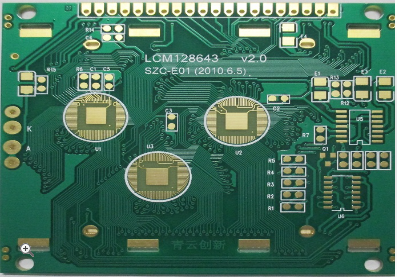PRODUCTS
High-frequency High-speed PCB Manufacturer for 5G Base Stations
2025-04-19

In an era where 5G technology is reshaping global communication, High-frequency High-speed PCBs have become the core \"nerve center\" of 5G base stations. These PCBs must achieve low signal loss, precise impedance control, and robust environmental adaptability in millimeter-wave bands above 28GHz, posing unprecedented challenges in material selection, manufacturing processes, and quality management. As a specialized manufacturer 深耕 (deeply rooted) in the communication electronics field, we provide end-to-end solutions for global 5G base station construction through technological innovation and capacity deployment.
I. High-frequency High-speed PCBs: The Technological Foundation of 5G Base Stations
The three core metrics of 5G base stations—high speed (10Gbps+), low latency (below 1ms), and massive connectivity (millions of devices per km²)—all rely on the signal integrity ensured by high-frequency high-speed PCBs. The technical challenges focus on two key dimensions:
1. Material Performance Breakthroughs
- Ultra-Low Loss Substrates: Using PTFE (Polytetrafluoroethylene) composite materials (dielectric constant Dk=2.1±0.05, dissipation factor Df<0.0005), signal attenuation is reduced by 60% compared to traditional FR-4 (Dk=4.2, Df=0.02), meeting the requirement of <0.5dB loss per inch at 28GHz.
- High-Temperature Resistance & Reliability: The BT resin substrate (220℃ temperature resistance, CTE=13ppm/℃) used in Huawei\'s 5G base station PA modules maintains ±3% impedance stability in temperature ranges from -40℃ to 85℃, preventing signal distortion caused by thermal expansion/contraction.
2. Manufacturing Process Innovation
- Laser Drilling & Blind/Buried Via Technology: 16-layer HDI boards adopt 355nm UV laser drilling (100μm hole diameter, ±5μm positioning accuracy) with second-order blind/buried via processes, shortening signal paths by 40% and increasing in-board wiring density by 30%.
- Precision Impedance Control: Through Ansys HFSS simulation, achieve ±2% impedance control accuracy at 10GHz (industry standard ±5%), ensuring precise matching of 50Ω/75Ω characteristic impedance to reduce signal reflection and crosstalk.
II. Customized Solutions: Full-Process Collaboration from Design to Delivery
As a critical link between material suppliers and equipment manufacturers, we have built a vertically integrated system for \"requirement definition-joint R&D-mass production\":
1. Pre-Design Technical Alignment
- Signal Integrity Simulation: For Massive MIMO antenna array boards, optimize dielectric layer thickness (typical 0.127mm) and copper foil roughness (Rz<1.5μm) using SI9000 software, reducing insertion loss by 20%.
- Thermal Management Design: Embed micro-channel cooling structures in AAU (Active Antenna Unit) PCBs with 3oz thick copper foil (80A current capacity), controlling module temperature rise within 15℃ for long-term high-load outdoor operation.
2. Intelligent Manufacturing Capabilities
- Digital Production Lines: Introduce ASM fully automatic placement machines (±5μm accuracy) and German Manz laser cutters (500mm/s speed), achieving 24-hour rapid prototyping and reducing lead times for small-to-medium batches to 7-10 days.
- End-to-End Quality Control: Use AOI inspection (10μm resolution), X-Ray layer shift measurement (±25μm accuracy), and SATA III signal testing (6Gbps speed) to maintain a stable yield of 98.5%, 3% higher than the industry average.
3. Global Delivery Network
With two manufacturing bases in Shenzhen and Suzhou (total capacity 500,000㎡/month) and a Southeast Asia warehouse, we achieve fast logistics coverage: 3-5 days for North America, 5-7 days for Europe, and 2-3 days for APAC, effectively reducing customer supply chain costs.
III. Industry Practices: Deep Empowerment for Leading OEMs and Emerging Markets
1. Case Studies with Top Clients
- Huawei 5G Macro Base Stations: Mass-supplied 20-layer PTFE composite PCBs for Sub-6GHz BBU (Baseband Unit), supporting signal synchronization for 256TR massive antenna arrays and enabling Huawei to deploy over 1.5 million 5G base stations globally.
- Nokia mmWave Equipment: Customized 12-layer HDI boards for their mmWave micro base stations using embedded capacitor technology (±5% capacitance accuracy), suppressing high-frequency noise and enabling stable transmission in 200MHz channel bandwidth.
2. Emerging Market Expansion
In regions with accelerating 5G construction like India and the Middle East, we offer cost-effective solutions: modified PPO materials (Dk=3.0, 40% lower cost than PTFE) meet Sub-6GHz performance requirements, helping local operators control single-station PCB costs below $2000.
IV. Technological Readiness and Capacity Planning for 6G
As 6G R&D enters pre-commercial stages (target frequency 100GHz+), we are advancing forward-looking technologies:
- Material R&D: Collaborating with Dow Chemical to develop aerogel substrates (Dk=1.8), planned for sample testing in 2025;
- Process Upgrades: Investing $16 million in a 12μm line/space high-order HDI production line to support 3D packaging substrate integration;
- Green Manufacturing: 100% adoption of lead-free electroplating (Sn-Ag-Cu alloy) and water-based solder masks (90% lower VOC emissions), compliant with EU RoHS 3.0 and China\'s EIPCCM.
Conclusion: Partnering for Value in the 5G/6G Era
From 4G to 5G, and Sub-6GHz to millimeter waves, the evolution of high-frequency high-speed PCBs has always mirrored communication standard upgrades. As a specialized manufacturer, we don\'t just provide physical circuit boards—we strive to be our customers\' \"technology partners.\" Through continuous R&D investment (8% of annual revenue), strict quality control, and global service networks, we empower next-generation communication infrastructure. Whether you are an equipment manufacturer, system integrator, or emerging market pioneer, we deliver tailored solutions from material selection to mass production.
Contact us today to unlock the high-performance PCB technology for 5G base stations and embrace the limitless possibilities of 6G.
SUBSCRIBE
INQUIRY

